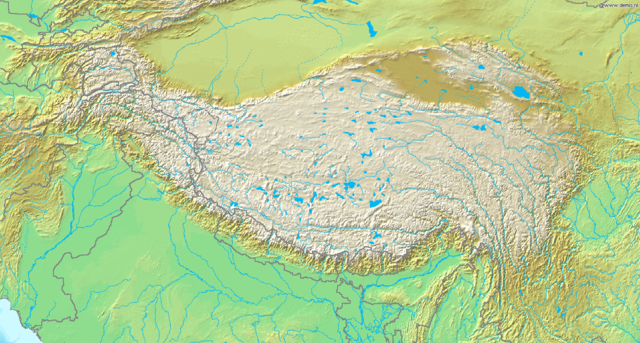Top Qs
Timeline
Chat
Perspective
Outline of Tibet
Plateau region in Asia From Wikipedia, the free encyclopedia
Remove ads
The following outline is provided as an overview of and topical guide to Tibet:


Tibet is a plateau region in Asia and the home to the indigenous Tibetan people. With an average elevation of 4,900 metres (16,000 ft), it is the highest region on Earth and is commonly referred to as the "Roof of the World."
A unified Tibet first came into being under Songtsen Gampo in the 7th century. From the early 17th century until the 1959 uprising, the Dalai Lamas (Tibetan Buddhist spiritual leaders) were, at least nominally,[1] heads of a centralised Tibetan administration, with political power to administer religious and administrative authority[1] over large parts of Tibet from the traditional capital Lhasa. They are believed to be the emanations of Avalokiteśvara (or "Chenrezig" [spyan ras gzigs] in Tibetan), the bodhisattva of compassion.
Remove ads
General reference
- Pronunciation: /tɪˈbɛt/ ⓘ, Tibetan pronunciation: [pʰøːʔ˨˧˩]
- Common English names: Tibet; or Xizang
- Official English names: Xizang Autonomous Region of the People's Republic of China
- Common endonym(s):
- Official endonym(s):
- Adjectival(s): Tibetan
- Demonym(s): Tibetans
- Etymology: Name of Tibet
- ISO region code for Xizang: CN-54
Geography of Tibet
Summarize
Perspective

- Location:
- Northern Hemisphere and Eastern Hemisphere
- Eurasia
- Time zone: China Standard Time (UTC+08)
- Extreme points of Tibet
- High: Mount Everest 8,848 m (29,029 ft) – highest point on Earth
- Low: Yarlung Tsangpo 1,615 m (5,299 ft)
- Demographics of Tibet
- Atlas of Tibet
Environment of Tibet
- Climate
- Flora (plants of Tibet)
- Lichens
- Grasses
- Ampelocissus xizangensis
- Anisodus tanguticus
- Aralia tibetana
- Borinda
- Buddleja crispa var. tibetica
- Buddleja forrestii
- Cedrus deodara
- Cupressus gigantea
- Cupressus torulosa
- Fagopyrum tibeticum
- Fallopia baldschuanica
- Incarvillea
- Juniperus indica
- Juniperus tibetica
- Luculia gratissima
- Paeonia lactiflora
- Russian sage
- Noble rhubarb
- Salvia castanea
- Salvia wardii
- Spikenard
- Tetrapanax tibetanus
- Tibetan elm
- Siberian elm
- Utricularia salwinensis
- Fauna
Geographic features of Tibet
- Tibetan Plateau
- Surrounding mountains:
- Lake Region (Changtang):
- River region:
- Yellow River
- Yangtze River
- Yalong River
- Salween River (Nu)
- Mekong (Lancang)
- Indus River
- Sutlej
- South Tibet Valley:
Administrative divisions of Tibet
Administrative divisions of Tibet
Tibet is divided into 7 prefecture-level divisions, 73 county-level divisions, and 692 township-level divisions. The 7 prefecture-level divisions are:
- Lhasa City
- Nagchu Prefecture
- Chamdo Prefecture
- Nyingtri Prefecture
- Shannan Prefecture
- Shigatse Prefecture
- Ngari Prefecture
There are also three traditional provinces or regions of Tibet:
Remove ads
Government and politics of Tibet
Branches of the government of Tibet
Executive branch of the government of Tibet
Legislative branch of the government of Tibet
Judicial branch of the government of Tibet
Foreign relations of Tibet
International organization membership
- none [2]
Local government in Tibet
Law and order in Tibet
Law of Tibet
Government in exile
History of Tibet
- List of rulers of Tibet
- Neolithic Tibet
- Zhangzhung
- Pre-Imperial Tibet
- Tibetan Empire
- Tang–Tibet relations
- Era of Fragmentation
- Guge
- Song–Tibet relations
- Mongol conquest of Tibet
- Tibet under Yuan rule
- Bureau of Buddhist and Tibetan Affairs
- Imperial Preceptor
- Dpon-chen
- Phagmodrupa dynasty
- Rinpungpa
- Tsangpa
- Ming–Tibet relations
- Priest and patron relationship
- Ganden Phodrang
- Tibet under Qing rule
- Chinese expedition to Tibet (1720)
- Lifan Yuan
- Lhasa riot of 1750
- Golden Urn
- Chinese expedition to Tibet (1910)
- Xinhai Lhasa turmoil
- History of European exploration in Tibet
- British expedition to Tibet
- Tibet (1912–1951)
- Sino-Tibetan War
- Qinghai–Tibet War
- History of Tibet (1950–present)
- Annexation of Tibet by the People's Republic of China
- Battle of Chamdo
- CIA Tibetan program
- Protests and uprisings in Tibet since 1950
- 1959 Tibetan uprising
- 1987–1989 Tibetan unrest
- 2008 Tibetan unrest
- Self-immolation protests by Tibetans in China
Remove ads
Culture of Tibet
- Tibetan people
- Cuisine of Tibet
- Traditional Tibetan medicine
- Tibetan calendar
- Tibetan Festivals
- Public holidays
- Newspapers in Tibet
- Sport in Tibet
Religion in Tibet
Art in Tibet
National symbols of Tibet
Remove ads
Economy and infrastructure of Tibet
See also
References
External links
Wikiwand - on
Seamless Wikipedia browsing. On steroids.
Remove ads
